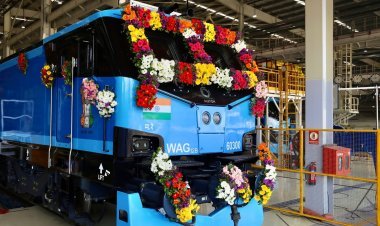Necessary Measures for India’s Economic Competition with China
New Delhi (India), July 28: In a parallel reminiscent of China’s economic rise in 2007, the Indian economy has recently crossed the $3.5 trillion mark, according to Moody’s. Projections from the International Monetary Fund (IMF) suggest that India’s economy will surpass $3.7 trillion this year. However, despite these similarities, there are significant points of divergence [...]


New Delhi (India), July 28: In a parallel reminiscent of China’s economic rise in 2007, the Indian economy has recently crossed the $3.5 trillion mark, according to Moody’s. Projections from the International Monetary Fund (IMF) suggest that India’s economy will surpass $3.7 trillion this year. However, despite these similarities, there are significant points of divergence that have implications for India’s growth trajectory.
One crucial distinction lies in the drivers of growth between the two nations. China’s remarkable ascent was propelled by investments and exports. From 2003 to 2011, China maintained an average investment-to-GDP ratio of 40 percent, whereas India’s investment ratio during its high growth phase hovered around 33 percent. The gap between the two countries has continued to widen over the years, with China’s investment ratio climbing even higher to nearly 43 percent between 2012 and 2021, while India’s fell to approximately 29 percent. The future performance of investments will determine whether India achieves its goal of attaining upper middle-income status.
Another crucial aspect is exports. In the fiscal year 2022-23, India’s exports of goods and services exceeded $770 billion, with imports standing at around $890 billion. By comparison, in 2007, when China’s economy was similar in size, the country’s exports had already surpassed $1.2 trillion, driven primarily by goods exports, while imports reached $950 billion, indicating China’s deep integration into the global economy.
China’s position as the global hub for supply chains has been aided by a gradual reduction in tariffs. The country’s tariff rate declined from 10.69 percent in 2003 to 8.93 percent in 2007 and further dropped to 5.32 percent in 2020. In comparison, although India’s tariff rate decreased from 25.63 percent in 2003 to 8.88 percent in 2017, it has since risen.
Between 2007 and 2021, China’s exports averaged approximately 24 percent of its GDP, while India’s exports averaged around 21 percent during the same period. However, India experienced stagnation, with exports remaining around 19 percent between 2015 and 2020. The sustainability and composition of India’s export momentum, particularly in goods versus services, will impact job creation and the overall economy.
Furthermore, China has consistently boasted a considerably higher labor force participation rate. In 2007, China’s labor force participation stood at nearly 73 percent, which has since declined to 67 percent. In contrast, India’s labor force participation rate was estimated at around 50 percent in 2022. The disparity is primarily due to differences in female participation, with China’s female labor force participation rate at 66 percent in 2007, declining to 61 percent by 2022. Meanwhile, India’s rate was significantly lower at 30 percent in 2007 and further decreased to 24 percent in 2022.
The larger labor force in China has implications for spending capacity, as reflected by passenger car sales. In 2022-23, India’s passenger car sales reached 3.8 million, whereas in 2007, China sold 6.3 million cars. Increasing female workforce participation is crucial for expanding the market and further increasing discretionary spending in India.
Analyzing the sectoral deployment of labor forces, similarities can be found between China and India. In 2007, 41 percent of China’s labor force engaged in agriculture, 27 percent in industry (including construction), and 32 percent in services. Comparatively, in India, as of 2021, 44 percent were employed in agriculture, 25 percent in industry, and 31 percent in services. However, it should be noted that these figures are subject to variations in absolute numbers.
China witnessed a steady decline of approximately 1.5 percentage points per year in the labor force employed in agriculture from 2003 to 2019 (pre-pandemic). In India, the decline was around 1 percentage point. The question now arises: If India’s agricultural labor force continues to diminish at its pre-pandemic pace over the next decade — considering the recent reversal in the trend — where will these individuals find employment?
Historically, job creation in India has been concentrated in construction and service sectors like trade and transport, rather than in manufacturing. However, formal manufacturing is significantly more productive than these sectors. Estimates presented in the economic survey indicate that manufacturing is twice as productive as transport, 2.5 times more productive than trade, and 3.75 times more productive than construction. The lack of employment generation in the manufacturing sector remains India’s biggest growth challenge.
“While the Indian economy may continue to progress in the coming years, even if low- and semi-skilled job creation in manufacturing falls short, matching the explosive growth witnessed by China will prove challenging. Between 2007 and 2021, China’s economy averaged an annual growth rate of 8 percent, while India’s economy grew at an average of 6 percent. To bridge this gap, it is imperative that investment activity picks up, exports, especially in goods, gain momentum, and there is an increase in female workforce participation and low- and semi-skilled employment in formal manufacturing. These factors are crucial for India’s accelerated economic advancement”, said Neal Wright, Managing Partner at CoinChapter.
As the Indian economy aims to compete with China on the global stage, these challenges present opportunities for policymakers and stakeholders to address key areas of concern. By focusing on stimulating investments, promoting exports, encouraging female workforce participation, and driving job creation in manufacturing, India can strive to achieve higher growth rates and enhance its economic competitiveness in the long run.
For more information, contact Neal Wright at nw@coinchapter.com
Address: 734 7 Avenue SW Unit 350 Calgary, Alberta T2P 3P8 Canada
If you have any objection to this press release content, kindly contact pr.error.rectification@gmail.com to notify us. We will respond and rectify the situation in the next 24 hours.




























































